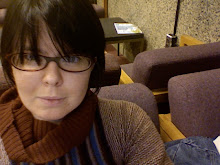It’s had me wondering about why acrostics are used so rarely. Why there seems to be something so “uncool” about them—I have to say, I’ve really enjoyed using them when I’ve thought of it, though I think of it so rarely. Maybe it’s a sense that there’s some riddle there, but the answer is too “easy”—and yet who ever looks at a poem vertically to see if there is an acrostic embedded into it? Considering the fact that I so often set myself arbitrary restrictions, I think I’m going to revisit acrostics.
 When I first bought the Norton Anthology of Postmodern American Poetry I was fascinated by the fact that it had some poetry by John Cage in it. With my music background, Cage has been someone I associated with music from the age of fourteen, when a teacher played me a record—a record!—of the 4’33”. Later I’ve been delighted when I’ve encountered his work elsewhere. His writings on silence were probably the most profound pieces of musical philosophy I have read. Then, when I took one of my early trips to Brisbane to work on the opera I was then writing, The Crimson, I took myself to the National Gallery, where they have a painting by Cage in the collection. A few years ago, in San Francisco, I was similarly delighted when I came across a “collaboration” between Robert Rauschenberg and Cage—an extremely long piece of paper that went around the room, with a tire track from a painted tyre across the whole of it. These little instances of his aleatoric work spilling out from the music. And—his poems.
When I first bought the Norton Anthology of Postmodern American Poetry I was fascinated by the fact that it had some poetry by John Cage in it. With my music background, Cage has been someone I associated with music from the age of fourteen, when a teacher played me a record—a record!—of the 4’33”. Later I’ve been delighted when I’ve encountered his work elsewhere. His writings on silence were probably the most profound pieces of musical philosophy I have read. Then, when I took one of my early trips to Brisbane to work on the opera I was then writing, The Crimson, I took myself to the National Gallery, where they have a painting by Cage in the collection. A few years ago, in San Francisco, I was similarly delighted when I came across a “collaboration” between Robert Rauschenberg and Cage—an extremely long piece of paper that went around the room, with a tire track from a painted tyre across the whole of it. These little instances of his aleatoric work spilling out from the music. And—his poems. The poem I remember was an acrostic—a centred acrostic, with “MARK TOBEY” appearing as a column down the middle of the poem, the work surrounding it.
I want to reread John Cage. I want to reread X: Writings on Silence.
Lewis Carroll wrote a lot of acrostic poetry too. (Incidentally, I’ve recently been very upset to find out how many people I know have not read Alice in Wonderland, which I feel like has been with me my whole life—though really only since about the age of five.)
So—again I’m asking: why do acrostics seem uncool?
And, while epigraphs are in my head, they do actually strike me as having a similar function—or the possibility of that function, if people see the acrostic—in being a place where you can provide a framing text. Though I suppose it is also a framing text that could go unnoticed.
I wrote a poem on Sunday. It made me almost dazzlingly happy, though it is not finished. I think I’m going to try for a pile (or rather notebookful) of poems in their early stages over the next few weeks, and when I get back from Panama I’ll try to whip them into shape. Along with a lot of other poems I want to revisit. Poems! I’m so close—so tantalisingly close—to being able to think of poems. My day will come.




